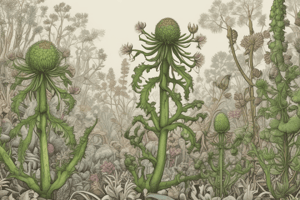Podcast
Questions and Answers
What are non-vascular plants?
What are non-vascular plants?
Simple plants without a vascular system.
What is the dominant stage in mosses?
What is the dominant stage in mosses?
Gametophyte.
Which structure in mosses is responsible for producing sperm?
Which structure in mosses is responsible for producing sperm?
- Antheridia (correct)
- Zygote
- Sporophyte
- Archegonia
Mosses reproduce using seeds.
Mosses reproduce using seeds.
What type of plants are seedless vascular plants?
What type of plants are seedless vascular plants?
Which of the following are types of seeding vascular plants?
Which of the following are types of seeding vascular plants?
Match each plant type with its description:
Match each plant type with its description:
What is a characteristic of asexual reproduction?
What is a characteristic of asexual reproduction?
What is the process called when an organism grows out of the body of the parent?
What is the process called when an organism grows out of the body of the parent?
In sexual reproduction, offspring have characteristics from only one parent.
In sexual reproduction, offspring have characteristics from only one parent.
Flashcards are hidden until you start studying
Study Notes
Plant Reproduction
- Non-Vascular Plants
- Simple plants without a vascular system
- Typically smaller due to limited water and nutrient transport
- Examples: Moss, Algae
- Moss Life Cycle
- The dominant stage is the gametophyte, which produces male and female reproductive structures: antheridia and archegonia.
- Sperm from the antheridia swims through water to reach the archegonia, forming a zygote.
- The zygote develops into a sporophyte, dependent on the gametophyte for nutrients.
- The sporophyte produces spores through meiosis in a capsule at the end of a stalk (seta).
- Mature spores are released into the environment, completing the cycle.
- Seedless Vascular Plants
- Simple plants with a vascular system
- Taller than non-vascular plants due to efficient water distribution
- Examples: Fern
- Seeding Vascular Plants (Spermatophytes)
- Divided into two types: Gymnosperms and Angiosperms
- Seeds are derived from ripened seed-producing plants.
Angiosperms vs. Gymnosperms
- Angiosperms
- Flowering plants with seeds enclosed within fruits/flowers.
- Rely on pollinators like bees.
- Examples: Apple tree, Sunflower.
- Gymnosperms
- Seed-producing plants with uncovered seeds, typically found in cones.
- Examples: Pine trees.
Animal Reproduction
- Asexual Reproduction
- Budding: Offspring grows from the parent's body. Example: Hydra.
- Gemmation: Organism develops gemmules (buds) that grow into new organisms. Example: Sponges.
- Fragmentation: Part of an organism develops into another. Example: Flatworms.
- Sexual Reproduction
- Two organisms contribute genetic material to offspring, resulting in a new gene combination.
Studying That Suits You
Use AI to generate personalized quizzes and flashcards to suit your learning preferences.




